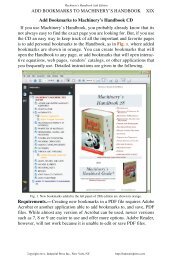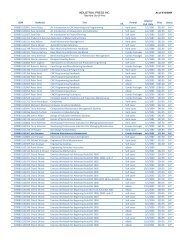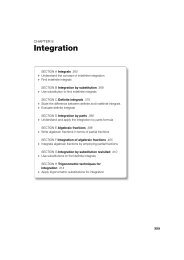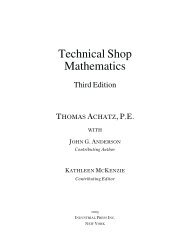computer numerical control programming basics - Industrial Press
computer numerical control programming basics - Industrial Press
computer numerical control programming basics - Industrial Press
Create successful ePaper yourself
Turn your PDF publications into a flip-book with our unique Google optimized e-Paper software.
terms from any other point along three perpendicular axes. This<br />
concept fits machine tools perfectly since their construction is<br />
generally based on three axes of motion (X, Y, Z) plus an axis of<br />
rotation. On a plain vertical milling machine, the X axis is the<br />
horizontal movement (right or left) of the table, the Y axis is the<br />
table cross movement (toward or away from the column), and the<br />
Z axis is the vertical movement of the knee or the spindle. CNC<br />
systems rely heavily on the use of rectangular coordinates because<br />
the programmer can locate every point on a job precisely.<br />
When points are located on a workpiece, two straight intersecting<br />
lines, one vertical and one horizontal, are used. These lines must<br />
be at right angles to each other, and the point where they cross is<br />
called the origin, or zero point (Fig. 1)<br />
Fig. 1 Intersecting lines form right angles and<br />
establish the zero point (Allen-Bradley)<br />
Fig. 2 The three-dimensional<br />
coordinate planes (axes) used in<br />
CNC. (The Superior Electric<br />
Company)<br />
The three-dimensional coordinate planes are shown in Fig. 2. The<br />
X and Y planes (axes) are horizontal and represent horizontal<br />
machine table motions. The Z plane or axis represents the vertical<br />
tool motion. The plus (+) and minus (-) signs indicate the direction<br />
from the zero point (origin) along the axis of movement. The four<br />
quadrants formed when the XY axes cross are numbered in a<br />
counterclockwise direction (Fig. 3). All positions located in quadrant<br />
1 would be positive (X+) and positive (Y+). In the second<br />
quadrant, all positions would be negative X (X-) and positive (Y+).<br />
In the third quadrant, all locations would be negative X (X-) and<br />
negative (Y-). In the fourth quadrant, all locations would be positive<br />
X (X+) and negative Y (Y-).<br />
8








